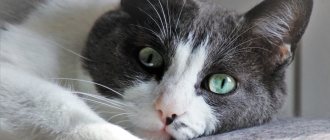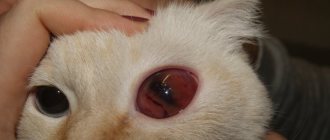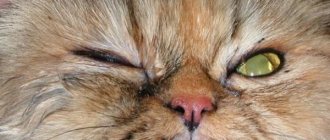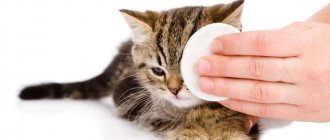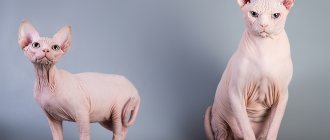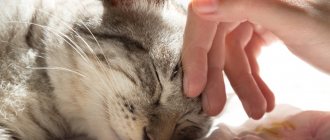13250Pavel
2
Ten days after birth, the kittens’ eyes begin to open, initially narrow slits appear, and then two small buttons glow like beads. This is a normal process. But what to do when the kitten’s eyes do not open? This phenomenon causes concern among owners.
Watching the little beads open is just a pleasure. To begin with, tears appear in the inner corner, then a small crack forms, which increases every day. As a result, small shiny buttons appear. But if your eyes are difficult to open, is it worth doing anything?
At what period do kittens' eyes open?
For kittens, opening their eyes is an important event that occurs within two weeks of their birth. The process lasts about a week. First, small cracks appear, which expand more and more every day. For the first week, newborn babies do not see or hear anything.
Newborn babies
For your information! It is recommended that at the very beginning of life they should be kept in a dark room, since bright light has a bad effect on the development of the visual organs.
As soon as the eyes open, they still look like cloudy, motionless dots with a film on them. The pupil becomes mobile after three days, the membrane becomes transparent.
Cubs are born blind. Nature designed it this way to preserve vision. There are also several reasons for this phenomenon:
- babies' vision organs are closed to protect them from infections that can be transmitted from a cat;
- this will help avoid infection in the womb from amniotic fluid;
- Pregnancy in a cat proceeds very quickly, and therefore the visual organs do not have time to develop, and the process continues after birth.
Note! In cats, the process occurs faster than in males. Also, the eyes open earlier in a baby who is stronger and more active than others.
Opening process
It is believed that it is useful to hold small kittens in your arms. In such a situation, the cat will begin to lick them more intensively, this will speed up the development process.
My cat's eye is watering, what should I do?
There are situations when both experienced owners and beginners wonder: the cat’s eye is watering, what should I do? The causes of this problem and methods of treatment can be very different. You can remove some of the factors that trigger lacrimation yourself. In other cases, the help of a veterinary ophthalmologist or epidemiologist (specialist in infectious diseases) will be required.
Why are tears needed and where do they come from?
Mammals' eyes were inherited from waterfowl ancestors and are designed in such a way that they can work if their surface is dry. There are no problems with this in the sea, but on land the lacrimal glands, which constantly produce liquid, are responsible for hydration.
A passage begins in the corner of the eye that leads into the nasal canal and tears flow down it. We can say that the cat's eye is constantly watering.
The system works much like a bathtub drain: if the plug is open and the water flow is not too empty, the bathtub appears empty, but water flows through it.
Causes of excessive tears
Tears outside the eye appear for two reasons: if tears are produced in excess or if the outflow is impaired.
Most often, a cat's eye waters because the nasolacrimal duct is blocked.
Causes of obstruction of the lacrimal duct:
Infectious and inflammatory processes in the mucous membranes of the eyes, eyelids and
nasopharynx. The inflamed mucous membrane swells, becomes thicker and mechanically blocks the exit from the eye. This can happen with conjunctivitis, blepharitis, and rhinitis, both infectious and non-infectious. Blockage of the nasolacrimal duct. Cats can get a variety of things into their noses, from dust to insects. They block the channel, as a result the cat’s eye waters - the “bathtub” overflows.
Curvature and narrowing of the nasolacrimal duct. This is usually a congenital phenomenon and often occurs in cats with a depressed muzzle profile (Persian, Himalayan). The canal can become bent even after injuries in the area of the nose and cheekbone, and then the cat’s eye constantly waters. Such changes are usually incurable
Excess tears appear if:
Something got into my eye.
Reasons for not opening eyes
Cats fight: the main reasons for the behavior and what can be done to wean them off
The eyes of small kittens open gradually. First, a small crack appears, most often this can be observed from the inside. Then the iris becomes visible. They become cloudy within a week, so you should not expose babies to bright light. Most often, the cat itself brings the cubs out of hiding when the time is right.
Each kitten develops individually. Even within the same litter, some develop faster and more actively than others. There are often situations when the first kitten born begins to see before everyone else.
Late eye opening depends on several factors.
Breed
Each breed has characteristics at the genetic level. They consist in the fact that opening the eyes can take quite a long period of time. These breeds include:
- Siberian and British kittens. Their eyes open only on the 17th day after birth;
- Siamese, Abyssinian and Sphynx breeds are born with open eyelids, and already on the fourth day their vision is focused;
- Fold-eared Scots and Bengals begin to see clearly within a week after birth;
- Newborn ragdolls take the longest to open their eyes. This is due to the fact that their visual organs develop slowly. These pets begin to see only on the 21st day of life.
Beautiful kitty
Siberian kittens
For your information! Representatives of short-haired breeds develop faster than long-haired ones.
Accommodations
The conditions in which children are kept have a great influence on the process. Healthy kittens that receive the maximum amount of nutrients develop faster. Viruses and congenital pathologies slow down the process of formation of the visual organs.
Length of pregnancy in cats
The rate of vision development is affected by the gestation period. The longer a cat is pregnant, the faster the offspring opens their eyes. There are often situations when, during a long pregnancy, female kittens are born with their eyes open. In this case, you need to pay special attention to moisturizing the shell to avoid the development of diseases.
Description of the most likely causes
If a cat does not open one eye, then there is a high probability that the cause is related to injury. Two organs of vision are most often affected by viral infections. In older individuals, a problem with one eye may be associated with a tumor process, due to which the organ may increase in size and alarming symptoms appear in the form of bloody discharge or a foul odor. To make a diagnosis, an external examination of the animal must be carried out; if necessary, ophthalmoscopy is prescribed, with the help of which the following possible pathologies are excluded or confirmed:
- Blepharitis. An inflammatory process affecting mainly the edges of the eyelid. Leads to redness and swelling of the outer side of the eyelid. In most cases, it is accompanied by severe itching, due to which the pet can inflict even greater injuries on itself with its claws. If a cat’s eyes cannot open and redness of the eyelid is visible, then it is necessary to rule out blepharitis, which can be caused by a number of reasons. Most often, the inflammatory process is triggered by injuries (scratches from claws or tree branches) and congenital pathologies (entropion of the eyelid, double row of eyelashes). Sometimes an external examination by an ophthalmologist is sufficient to determine the extent of damage to the eyelid, conjunctiva or cornea. For minor damage caused by scratches, antibacterial drops (iris, tsiprovet) and ointments placed under the eyelid (korneregel, tetracycline) are prescribed. In difficult cases, the animal is put on a special medical cap to prevent the possibility of scratching.
- Injury. If a cat’s eyes do not open after playing or fighting with other animals, then it is necessary to conduct an external examination of the organ to identify scratches on the cornea, eyelid or conjunctiva. Even the slightest microtrauma to the cornea can cause significant discomfort to the pet when blinking. There is also a risk of developing an inflammatory process due to bacterial infection entering an open wound. Minor injuries heal quickly (for this, Tobrex and Kornegel drops are used in the form of an ointment, which is placed under the eyelid). But for deep corneal ulcers, systemic antibiotics are used until complete healing (this can take from 2 to 4 weeks, provided that there are no complications in the form of keratitis or uveitis).
- Turn of the century. It is considered a congenital pathology that can manifest itself at any period of life. The process can be triggered by eyelid trauma and viral infections. This problem most often occurs in Maine Coons, Persian and British cats. At first, the animal’s eye does not fully open; later, the eyelid may touch the cornea with every blink, which will lead to injury. The development of keratitis can lead to the conjunctiva becoming covered with a cloudy film. If the necessary assistance is not provided in time, the pet’s vision may decrease, and in some cases there is a risk of going blind in the damaged eye. The problem of entropion of the eyelids can only be solved surgically. The operation is performed under anesthesia. Excess eyelid flaps are trimmed and the wound is sutured. Healing takes 3-7 days.
- Incorrect eyelash growth. There are cases when an animal may experience abnormal growth of one or several eyelashes at once. Almost always, this process leads to injury to the cornea, as the eyelash grows inward and irritates the conjunctiva with every blink. At the initial stage, this may manifest itself in increased lacrimation, redness of the mucous membrane of the eyelid and conjunctiva. If the cat’s eyes do not open, then the situation could be complicated by keratitis and uveitis. Typically, these pathologies are accompanied by severe itching, due to which claw wounds may be present in the area of the pet's face. The problem can be resolved only by removing incorrectly growing eyelashes. This is done in a hospital setting, with an individual approach to pain relief or anesthesia in each case. In some cases, it is possible to carry out the procedure without using both.
- Foreign body. Animals can also get any debris into their eyes, which does not always come out with tears. This is especially true for splinters that can dig into the mucous membrane of the eyelid or conjunctiva. These can be plant seeds or needles from cacti. It is important to notice the problem in time and eliminate the irritating factor. In some cases, you can do this yourself using tweezers; sometimes you have to seek help from a veterinarian, who has a wider selection of gripping tools in his arsenal.
You need to understand that if a cat’s eyes do not fully open or they constantly squint, then it is necessary to look for and eliminate the irritating factor, since there is a risk of developing an inflammatory process with all the ensuing complications.
How to help kittens open their eyes
Why do cats' eyes glow in the dark: the main reasons
What to do if the kitten does not open its eyes? If the eyes of newborns do not open for more than 10 days, you need to carefully examine them. It is important to pay attention to traces of suppuration, mucus, and any discharge from under the eyelids. If at least one of these signs is present, you should definitely show the kittens to a veterinarian.
There are several ways you can help open your kittens' eyes.
Brewing tea
You need to brew strong black tea, cool it and strain. Using a cotton swab dipped in tea leaves, wash your eyes several times, repeating the procedure every evening.
Eye wash tea
Boric acid solution
To prepare, 2 teaspoons of boric acid are dissolved in a glass of warm water, the solution is used in the same way as tea leaves.
Baking soda solution
This recipe is suitable if your eyes are festering. Baking soda is diluted in the proportion of 0.5 teaspoon per glass of water. Use a cotton swab dipped in the solution to blot your eyes every evening.
Chamomile decoction
Chamomile decoction is used in the same way as tea.
It is strictly forbidden to self-administer medications, especially antibiotics. This can be harmful to the kittens' health.
Chamomile decoction - an old folk remedy
For your information! There are situations when animals have ankyloblepharon.
This is a pathology that represents a partial fusion of the eyelids. In such a situation, only surgical intervention is required.
The cat's eye is closed, what should I do?
The cat's eye is closed, what should I do?
Download file - The cat's eye is closed, what to do
Ru Mail My World Odnoklassniki Games Dating News Search All projects All projects. Categories All project issues Computers, Internet Topics for adults Auto, Motorcycle Beauty and Health Products and Services Business, Finance Science, Technology, Languages Philosophy, Unknown Cities and Countries Education Photography, Videography Horoscopes, Magic, Fortune telling Society, Politics, Media Legal advice Leisure , Entertainment Travel, Tourism Humor Food, Cooking Work, Career About projects Mail. Ru Animals, Plants Wildlife Pets Houseplants Garden Other living creatures. Questions - leaders Film of the year 'White Fang'. The dog who played in this film received a state award. Category leaders Julia Sh.
Features of eye washing
The eye wash procedure does not require any specific knowledge. But in order not to harm the animal, it is recommended to follow certain rules. Before you start processing, you must wash your hands with soap or a disinfectant solution. Then you need to moisten the gauze in the solution and carefully apply it first to one eye, and then to the other.
Why does a kitten's whiskers break: the main reasons and what to do
It is best to secure the kitten by wrapping it in a blanket so that it does not resist and does not harm itself. It is recommended to choose the position of the animal lying on its back. All movements should be smooth from the inner corner of the eye to the outer.
Important! It is strictly forbidden to press hard on the eyes. It is not recommended to make sudden movements, so as not to frighten the kitten even more.
Washing procedure
If the medicine needs to be instilled, it is necessary to open the eyelids slightly, then the drops are squeezed into the center of the eyeball.
Why does a cat not open one eye?
Cats' eyes are often damaged and injured in everyday life.
An animal can get injured on the street, in contact with relatives, or as a result of intense games with large objects. This is especially true for kittens, who, in the impulse of their activity, quite often injure themselves. Often, owners notice that the cat’s eye does not open and begin to sound the alarm. This phenomenon does not always require drug treatment, but in some cases the animal should be shown to a veterinarian as soon as possible in order to avoid dangerous complications.
Other Possible Problems
If more than two weeks have passed since birth, and one of the kitten’s eyes does not open, this should alert the owner. This phenomenon may be the cause of the development of a pathological deviation. It is best to show the animal to a doctor.
Important! If the cat's eyes do not open and are watering, this may indicate a foreign body. The appearance of pus indicates the development of conjunctivitis.
Young kittens are very vulnerable to viral infections. Harmful bacteria can come from both the external environment and the womb. Therefore, owners of newborn kittens often experience inflammation of the organs of vision.
Eye is leaking
The reasons why a kitten's one eye is watery can be due to many factors:
- the appearance of infection is the most common phenomenon. The most common are chlamydia, herpes and mycoplasmosis, which are also contagious to humans. The presence of infection can only be determined through analysis of eye wash;
- allergic reactions may occur to food, dust and household chemicals;
- mechanical eye injuries that appear either after active play of kittens or due to burns. A speck of dirt can also get into the kitten’s eye, which will cause injury to the cornea, the eye will begin to hurt and leak;
- infection of an animal with parasites;
- disruption of the gastrointestinal tract;
- prolonged exposure to lighting devices, a bright light source.
Only a doctor can name the exact reason why a kitten’s eyes are watering. The conclusion is made after the diagnosis. As soon as an accurate diagnosis is made, the doctor prescribes how to treat the cat.
Tearing will be considered normal when it comes to Scottish and British breeds. It all depends on the structure of the skull. Due to the fact that these breeds have a flattened muzzle, their eyes are susceptible to the influence of the environment, and they constantly leak. Owners of these breeds should contact a veterinarian if they see changes in their pet's behavior.
Important! You need to monitor the color of the discharge from the eyes. If tearfulness with pus is observed, it is necessary to immediately contact a veterinarian. Pus from the eyes indicates the beginning of the inflammatory process.
A kitten's eye is leaking
If clear discharge without blood or pus is detected, you can get rid of it at home. To do this, you can wash your pet's eyes with tea and chamomile infusion. Products sold in pet stores have a good effect. You can purchase eye drops that will produce results within 2 weeks. If after treatment the cat continues to squint his eyes, they close and run, you need to show him to the veterinarian.
Squints his eyes
Pet owners should be wary if their pet squints one eye. This indicates that he is experiencing pain and discomfort. Most often this is accompanied by severe lacrimation and suppuration. In this situation, you urgently need to show the animal to a doctor and take the necessary measures for treatment. Squinting of the eyes can occur for a number of reasons:
- the development of conjunctivitis is an inflammation of the mucous membrane, which is accompanied by swelling and purulent discharge. The diseased organ of vision becomes swollen, it begins to close and turn red. For treatment, special drops and rinsing are used. If the disease is detected late, antibiotic injections are prescribed;
- mechanical injury to the cornea, accompanied by severe pain. The complexity of such phenomena lies in the fact that microorganisms can enter small cracks in the corneal tissue and subsequently multiply. Particular attention is paid to injuries caused by claws, under which a large number of bacteria accumulate, as well as worm eggs;
- Allergic reactions can be to household chemicals, dust, or to flowers and plants. If a kitten begins to squint its eyes in order to identify the causative agent of the allergy and prescribe treatment, the doctor conducts a diagnosis by taking tests;
- increased eye pressure. Most often, this phenomenon occurs in old animals due to age-related changes. If treatment is not taken, this condition can lead to blindness;
- Corneal erosion or damage to the membrane are the most common reasons why a cat squints. The impetus for infection comes from injuries, burns, and viral infections. If left untreated, the disease will lead to serious consequences such as corneal erosion.
Conjunctivitis
If your pet begins to constantly squint his eyes, you need to urgently take him for examination.
Conjunctivitis in cats
Another reason why a cat’s left eye does not open is conjunctivitis. The disease develops due to the entry of dirt, fungal spores, parasites or pathogenic microorganisms under the eyelid. Usually, with conjunctivitis, the eyes become red and very watery, but with severe purulent inflammation they can turn sour. This makes the affected eye difficult to open, so the cat keeps it closed.
With severe inflammation, edema may develop. Then the closed eye increases in size, which is visible to the naked eye. When you try to unstick the cat's eyelids, the animal feels pain and breaks away. In this case, you need to visit a veterinarian. The doctor will prescribe drops and solutions to treat the affected eye. Antibiotic products are usually used. With timely treatment, conjunctivitis goes away within a few days.
Further care
As soon as the babies begin to see, the owner must provide them with proper care. Clean eyes without discharge indicate that the animal is healthy. Often small pets injure the surface of the cornea; specks or any dirt can get on it.
To prevent the development of inflammation, you need to regularly examine your babies and wipe their vision organs with clean cotton pads with water or tea leaves. Veterinarians may recommend special drops for kittens. The most commonly prescribed remedy is diamond eyes. Kittens whose eyes are washed regularly tolerate this procedure well. Treatment with tea leaves and instillation of drops are necessary until the animal begins to fully see and move well. But even after this, you need to examine the babies daily so as not to miss the development of inflammation.
Proper care of your animal's visual organs will ensure their proper development and healthy condition. It is important to ensure that the animal’s eyes open on time. If the pathology is left without attention and necessary treatment, it can lead to blindness.
Video
Causes and associated symptoms
Cats, if they are healthy, generally do not have excessive tearfulness or discharge from the eyes. There may be several reasons why a cat's eyes are watery:
- Perhaps dirt or debris has gotten into them, in this case it will be enough to wash them carefully and the problem will disappear.
- Tears can often be observed in small animals. It is imperative to find out why kittens have watery eyes. This may be normal, because the baby does not yet know how to take care of himself, especially if he has already been torn away from his mother cat. But sometimes the cause may be weakened immunity by various viruses.
- Sometimes, if a cat has increased tearfulness, the cause may be an allergic reaction of the animal to dust, pollen, flowers, household chemicals, food, wool, or a drug taken. Only a veterinarian can determine the exact allergen; he must be informed if any medication was given to the pet.
- Trauma may also be the cause, especially if the cat has water in one eye. She could have injured him with a branch, a toy, or while playing or fighting with other animals. In this case, you should contact a veterinary clinic as soon as possible. If your cat's eye is watering and won't open it, don't try to do it yourself to prevent complications.
- Often, if a cat has a watery eye or both eyes at once, this is a symptom of an infectious disease. For small, weak pets, infection can be very dangerous. One of the common diseases is conjunctivitis, which causes the eyes to become very red and swollen, and blood vessels may protrude. It is important to start treatment on time so that the infection does not spread to other organs.
- Infection can also be caused by parasites, the presence of which is determined after examination and testing.
- Sometimes a cat's tearfulness occurs due to a cold, in which case he may also experience symptoms such as a runny nose, sneezing and even coughing. The animal will be lethargic, refuses to eat, and prefers drinking and sleeping. If your pet goes outside, then in nature he can independently find plants for himself to alleviate his condition.
- Eye diseases may also be the cause of a cat's watery eyes. This may be an inflammation of the cornea, in which a thin film appears on the eye. If the lens of the pupil turns white, then it is possible that the cat has a cataract.
- The cause may also be increased pressure, both arterial, eye or cranial. In this case, if you do not contact a specialist in time, the cats’ vision can deteriorate greatly.
- In cats, the presence of watery eyes is sometimes considered a characteristic feature of the breed. This can be observed in cats that have a depressed muzzle - their nasolacrimal duct is deformed due to their flattened nose. Such symptoms can be observed in breeds such as Persians, Exotics, Britons or Rex.
What else to pay attention to
In addition to tearfulness, the owner may observe swelling in his pet's eyes, discharge from them, or dried crusts. The animal may be lethargic and hide from the light. If it is tormented, it rubs its eyes with its paws, which can injure them even more. The owner should also be alert to dullness of the eyes, changes in their color, excessive bulging or, conversely, hollowness. It is recommended to show the animal to a veterinarian at the first symptoms in order to begin treatment on time and avoid serious complications.
Basic treatment methods
Competent treatment should be prescribed by a veterinarian. All medications are prescribed only to them. You can do something at home only after examination and consultation with a specialist, and carelessness in using medications can deprive the cat of her vision. However, some general guidelines should be followed:
- You need to rinse the healthy eye first, and then the sore eye. Even if there is only one problem, it is necessary to rinse both eyes with furatsilin solution.
- In the case of an allergy, it is necessary to establish the cause of its occurrence and remove what causes the reaction.
- The eyes should be lubricated with medicinal ointments. If the discharge is purulent, antibiotics will be required. Use 2 times a day.
- In case of infection, the veterinarian will prescribe the necessary medications, but usually tetracycline ointment is used and chloramphenicol is instilled into the eyes.
- In case of trichiasis and eversion of the eyelid, the clamp cannot be removed in the postoperative period.
Ten days after birth, the kittens’ eyes begin to open, initially narrow slits appear, and then two small buttons glow like beads. This is a normal process. But what to do when the kitten’s eyes do not open? This phenomenon causes concern among owners.
Watching the little beads open is just a pleasure. To begin with, tears appear in the inner corner, then a small crack forms, which increases every day. As a result, small shiny buttons appear. But if your eyes are difficult to open, is it worth doing anything?
Preventive actions
To prevent your pet from experiencing increased tearfulness in one eye or two at once, the owner can worry about this by carrying out simple preventive measures. From an early age, little kittens need help and daily care for their eyes. You can wash them simply with boiled water or tea, or use the special “Diamond Eyes” preparation. This remedy should be instilled twice a day, 2 drops in each eye. In order for the eyes to be as open as possible, the kitten must be held by the scruff of the neck with its head raised up. After instillation, be sure to lightly wipe the eyes with a clean cotton pad so that the kitten does not scratch them.
It is useful for a healthy kitten or adult cat to wipe their eyes once a day with a clean cloth soaked in water. This will relieve them from souring and dry crusts that may appear after sleep. Wiping should be done carefully, without pressing, from the outer corner to the inner. Decoctions of medicinal herbs, such as chamomile, calendula, sage or St. John's wort, are also good for this procedure.
Daily care for your pet's eyes should be carried out before each use of medications prescribed by a doctor. If washing and prescribed treatment for several days does not give a visible positive effect, you must contact the veterinary clinic again.
The doctor will tell you how to treat the animal, the dosage and duration of medication use in each individual case. The owner can only provide first aid to his pet to alleviate his suffering. You must be attentive to the health of your pet.
- Perhaps dirt or debris has gotten into them, in this case it will be enough to wash them carefully and the problem will disappear.
- Tears can often be observed in small animals. It is imperative to find out why kittens have watery eyes. This may be normal, because the baby does not yet know how to take care of himself, especially if he has already been torn away from his mother cat. But sometimes the cause may be weakened immunity by various viruses.
- Sometimes, if a cat has increased tearfulness, the cause may be an allergic reaction of the animal to dust, pollen, flowers, household chemicals, food, wool, or a drug taken. Only a veterinarian can determine the exact allergen; he must be informed if any medication was given to the pet.
- Trauma may also be the cause, especially if the cat has water in one eye. She could have injured him with a branch, a toy, or while playing or fighting with other animals. In this case, you should contact a veterinary clinic as soon as possible. If your cat's eye is watering and won't open it, don't try to do it yourself to prevent complications.
- Often, if a cat has a watery eye or both eyes at once, this is a symptom of an infectious disease. For small, weak pets, infection can be very dangerous. One of the common diseases is conjunctivitis, which causes the eyes to become very red and swollen, and blood vessels may protrude. It is important to start treatment on time so that the infection does not spread to other organs.
- Infection can also be caused by parasites, the presence of which is determined after examination and testing.
- Sometimes a cat's tearfulness occurs due to a cold, in which case he may also experience symptoms such as a runny nose, sneezing and even coughing. The animal will be lethargic, refuses to eat, and prefers drinking and sleeping. If your pet goes outside, then in nature he can independently find plants for himself to alleviate his condition.
- Eye diseases may also be the cause of a cat's watery eyes. This may be an inflammation of the cornea, in which a thin film appears on the eye. If the lens of the pupil turns white, then it is possible that the cat has a cataract.
- The cause may also be increased pressure, both arterial, eye or cranial. In this case, if you do not contact a specialist in time, the cats’ vision can deteriorate greatly.
- In cats, the presence of watery eyes is sometimes considered a characteristic feature of the breed. This can be observed in cats that have a depressed muzzle - their nasolacrimal duct is deformed due to their flattened nose. Such symptoms can be observed in breeds such as Persians, Exotics, Britons or Rex.
What is the third eyelid: structure and function
As you know, almost all mammals have two eyelids - upper and lower. But many species have a so-called third eyelid (Tertia palpebra, inner eyelid, nictitating membrane), and cats are no exception.
A cat's third eyelid is a crescent-shaped fold of the lining of the eyelid (conjunctiva). It originates from the inner (closest to the nose) corner of the eye, one side tightly adjacent to the cornea and the other to the inner surface of both eyelids. The side adjacent to the cornea is covered with immune tissue (lymphoid follicles).
The third eyelid is a small fold of the conjunctiva of the eye.
Once upon a time, a person (more precisely, his ancestors) had a third eyelid. Now it has decreased to a small rudimentary fold at the inner corner of the eye.
A small cartilaginous plate, hidden in the folds of the third eyelid, is attached to the periosteum of the cat's skull, at the inner corner of the eyes, using ligaments. This is what helps him stay in shape. The plate itself is located between the layers of the mucous membrane of the eyelid and resembles the letter “T” in shape, its “hat” is curved in the shape of the eyeball. The third eyelid itself is attached to the “hat”, and the appendages of the lacrimal ducts and Harder’s gland are attached to the “trunk”.
The movement of the inner eyelid is provided by the muscles of the eyelids and partly by the nervous system (sympathetic). The eyelid itself is quite large (it completely covers the cornea), most of it is hidden in the eye socket. Can be pigmented (various shades of brown) or without pigment (pale pink).
As a rule, the third eyelid is almost invisible
So, the third eyelid is a very complex structure. And it performs a lot of important functions:
- Distributes antibodies produced by immune tissue throughout the cornea (they protect the eye from infections).
- Distributes tear fluid produced by the lacrimal ducts and Harder's gland throughout the cornea.
- Its outer edge, thin and elastic, acts like a brush, collecting debris (dust particles and other small particles) that have fallen on the cornea.
- It protects the cat's eye during hunting and other activities.
Previously, veterinarians believed that the third eyelid was a vestigial organ (like a wisdom tooth or appendix) and removed it to facilitate examination of the eye. But now scientists have proven its importance for cats.
The full function of the third eyelid has not yet been studied
When you can't do without a veterinarian
Experienced owners can deal with simple cases of lacrimation on their own by rinsing and using veterinary eye drops. But there are serious symptoms that require immediate medical attention.
Signs of serious illnesses that cannot be cured on your own:
- The discharge from the eye is viscous, thick, opaque; tears are colored in dark gray, green, bright yellow tones; lacrimation increases every day;
- Tearing appeared suddenly, profusely, accompanied by wheezing and swelling on the face - this is how anaphylactic shock begins in cats, in which case the animal needs immediate veterinary help! In addition to copious tears, the cat has lost its appetite or has a fever, coughing, diarrhea or severe lethargy;
- Incorrectly growing eyelashes were found in the eye. They constantly injure the mucous membrane of the eye, it is very painful. Simply removing eyelashes will not solve the problem; they will grow back very quickly. Only surgery on the eyelid will help, which will correct its position so that the eyelashes do not touch the conjunctiva.
A timely visit to a doctor will save your cat’s life!
Cats' eyes are often damaged and injured in everyday life. An animal can get injured on the street, in contact with relatives, or as a result of intense games with large objects. This is especially true for kittens, who, in the impulse of their activity, quite often injure themselves.
Often, owners notice that the cat’s eye does not open and begin to sound the alarm. This phenomenon does not always require drug treatment, but in some cases the animal should be shown to a veterinarian as soon as possible in order to avoid dangerous complications.
Most often, a cat does not open one eye when a grain of sand, speck or any other foreign body enters it. Movement of the eyelids and eyeball causes pain, so the animal prefers to keep the eye closed. A characteristic symptom of this phenomenon is profuse lacrimation from a closed eye. Over time, tears will wash away the debris from the eye, and the cat will no longer keep it closed. This usually happens after a few hours.
Another likely reason that a cat’s eyes won’t open is an injury while washing itself. If an animal vigorously rubs its muzzle with its paws, it may accidentally damage the mucous membrane of the eye, or get hair under the eyelid. This causes discomfort, so the cat keeps the eye closed until the mucous membrane is restored or tears wash out the hair.
Cats often come into conflict with their relatives. If a cat comes back from a walk dirty, wounded and does not open one eye, it means he has experienced a serious fight with a competitor for his territory. In this case, it is recommended to observe the behavior of the animal. If the cat feels well, despite the injuries, demonstrates a normal appetite and normal behavior, there is no cause for concern. After a short time, the mucous membrane will recover and the cat will open its eye again.
The alarm should be sounded if wounds are visible around the eye, and blood, mucus or pus oozes from under the closed eyelid. If you notice such symptoms, your cat should be taken to the veterinarian as soon as possible to avoid loss of vision. Sometimes conflicts with relatives lead to severe injuries, and bleeding from a closed eye may indicate severe damage.
If the cat's right eye does not open, it is recommended to wait several hours. In most cases, a cat will keep its eyelids closed due to a common household injury. If there is no foreign discharge, and only slight lacrimation is observed, there is no reason to panic. If a cat keeps its eye closed for more than a day, you should show the animal to a veterinarian. It may be necessary to remove the foreign body. To prevent infection of the damaged eye, the doctor will prescribe antibacterial drops, solution or special gel.
Diagnosis and treatment
What to do if a kitten has watery eyes, how to treat it? As soon as the owner notices increased tearfulness in his pet, he can rinse his eyes with boiled water or tea. The veterinarian can find out the reason for this phenomenon by talking with the owner and based on the results of some tests. To make an accurate diagnosis, it is sometimes necessary to take a swab from the conjunctival sac for analysis. If worms are suspected, an animal's stool sample is taken for examination.
If a kitten has watery eyes and conjunctivitis is detected, you can rinse with a weak solution of furatsilin or potassium permanganate, or chamomile decoction. It should be taken into account that it is necessary to rinse not only the diseased eye, but also the healthy one, to prevent the disease. There should be a separate cotton swab for washing for each eye. For the bacterial form of the disease, you can use medicinal ointments, which are applied up to 3 times a day.
We recommend reading: Suspicion of Diabetes in a Dog
If the eye is injured, before contacting a doctor, the owner can rinse the pet with saline solution and then treat it with 1% tetracycline ointment. If the eye is swollen or increased in size after an injury, the cornea should not be allowed to dry out. To do this, you need to drip clean warm water into it every 5 minutes. If a foreign body has entered the organ, the doctor injects the animal with an anesthetic before removing it. Then the eyelid is turned outward and the procedure is performed using tweezers.
If the cause of increased tearing is a disease such as ulcerative blepharitis, then some areas of the eyelids will need to be cauterized, after which they will be lubricated with antibiotic ointment. Entropion of the eyelids will have to be treated surgically; to prevent suppuration, the eyelids are treated with an antiseptic.
If worms are detected, the doctor, after determining the type of parasite, prescribes antiparasitic drugs to the patient. During the treatment of allergies, hormonal medications may be prescribed. For many diseases, the doctor prescribes vitamin therapy to strengthen the cat’s immune system.
